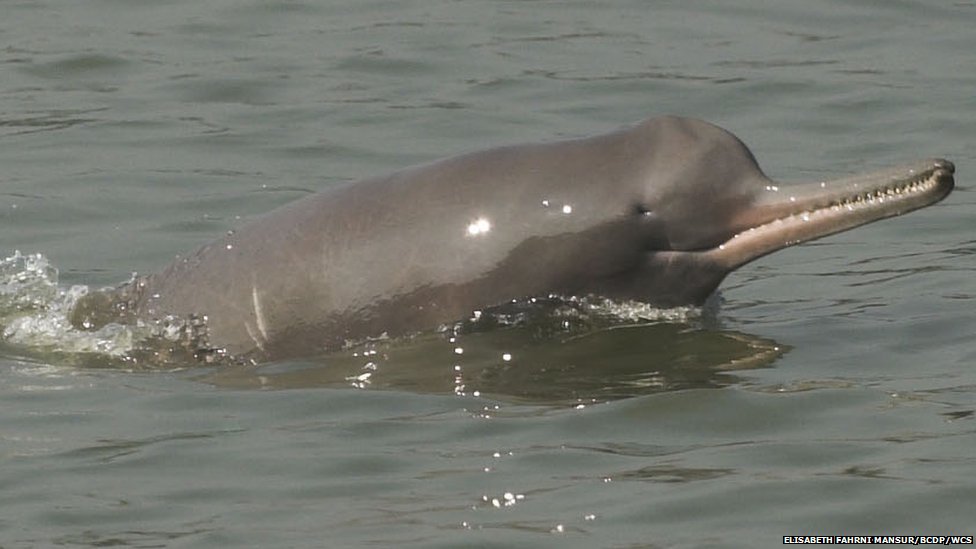
Tek Mahato Tharu had only heard from his grandfathers that dolphins in Nepal were a common sight in yesteryear. But as he grew up, he could not spot them in the Narayani river close to his house. He thought the grandfather told him a story.
However, in these last two months, Mahato has not only seen the dolphins but also taken photos and made the country aware of how the dolphins are making the much-awaited comeback to the Narayani river.
“I heard that dolphins in Nepal, including in the Narayani, were spotted in 2018, but only last year, during the bird census, I saw two dolphins near the Bhelauji border point,” a nature guide in the area and young wildlife photographer Mahato says that people like him have seen dolphins many times since then in Nawalpur, Amaltari and Triveni regions.
“It is a matter of pride to see dolphins in our Narayani, and a great pleasure to see them up close.”
Dolphins have been sighted in the Nandpur, Golaghat, Amaltari, Pitaujighat and Devghat areas also. But what does it mean for Nepali rivers?
Dolphins in Nepal
Conservationist DB Chaudhary echoes Tharu’s voice as has seen the dolphins in the Amaltari area.
“Some 40 to 50 years ago we used to see them in the Narayani river. I remember going to the river to catch sight of them when I was young.”
Then, dolphins in Nepal became a rare sight, just one to two in this last decade. But in the last five or six years, they are now being more common.

A dolphin conservation action plan prepared by the Department of National Parks and Wildlife Conservation, quoting a 2017 assessment, said there are less than 5,000 Asian river dolphins in the world, including the 3,500 of the Ganges subspecies. Meanwhile, a 2016 study estimated some 60 to 50 dolphins in Nepal.
The Ganges river dolphin (Platanista gangetica) is a freshwater dolphin found in the Ganges-Brahmaputra-Meghna and Karnaphuli-Sangu river systems in Nepal, India and Bangladesh. It is one of the four extant species of freshwater dolphins.
Some physical characteristics of the Ganges river dolphin include a long, pointed snout and a low triangular dorsal fin. Their eyes are small and placed on the sides of their head, which gives them poor eyesight but an excellent sense of hearing and echolocation.
They are known to be very social animals and they are often found in groups of two to 10. They are also known to be active swimmers and can be seen leaping out of the water. They use echolocation to navigate and find food, which mostly consists of fish and crustaceans. Their population is also taken as an indicator of the overall health of the river ecosystem.
The dolphin exhibit preference for areas that create eddy countercurrents, such as small islands, sand bars, river bends, and convergent tributaries. In the monsoon season, dolphins migrate locally to tributaries and then return to larger river channels in the dry, winter season.
“They rest in the deep waters and near the gorges where there is a thinner settlement. They travel both upstream and downstream.”
Why did the population of dolphins in Nepal decrease?
The Ganges river dolphin was classified as endangered in the IUCN Red List of Threatened Species in 1996 as the species’ population was declining in its entire distribution range. The threat position has remained intact to date.
Its population is considered to be endangered due to habitat loss, pollution, overfishing and more tourism activities, which have led to a decline in the numbers. “There is not only one reason behind it. All the reasons, including climate change and its cascading impacts, have been the factors behind the decreased sightings,” says Chaudhary.
Active in the observation of dolphins in Nepal since 1996, Chaudhary says, “Human intervention seems to be the most damning act against these dolphins. The dams built in the rivers including the Triveni barrage on the Narayani-Gandak river make it difficult, almost impossible, for dolphins to swim against the river flow and reach the points they are being seen this time.”
The IUCN has also acknowledged this as a problem for dolphins and their movement as well as endangering their habitat.
Other factors that threaten the species including other marine lives are illegal fishing activities and the use of nets to fish that get entangled and entrap the bigger species too. All have been posing a challenge to its conservation.

Moving towards conservation now
Though it is not certain that the dolphins seen in all these places are the same, Chaudhary says he has spotted only two dolphins in Narayani recently. But, regardless of the number, he says that the conservation efforts should be expedited to make sure Nepal does not lose sight of the mammals again.
The department’s Dolphin Conservation Action Plan (2021-2025) in Nepal is aimed at conserving the number of dolphins in Nepal by assessing their conservation status, setting conservation priorities, identifying key issues, reducing anthropogenic pressure on aquatic habitats and addressing them through viable action plans to ensure the long-term survival of the species.
Besides, Chaudhary says Nepal also needs a water conservation policy to make sure that it is implemented properly. In the policy, he says, human intervention as well as the water pollution level and its impacts on dolphins in Nepal should be specially focused on to ensure that the mammals do not shy away again. Apart from that advocacy on all levels should be ensured along with awareness among the locals and those involved in fish farming, he stresses.



















